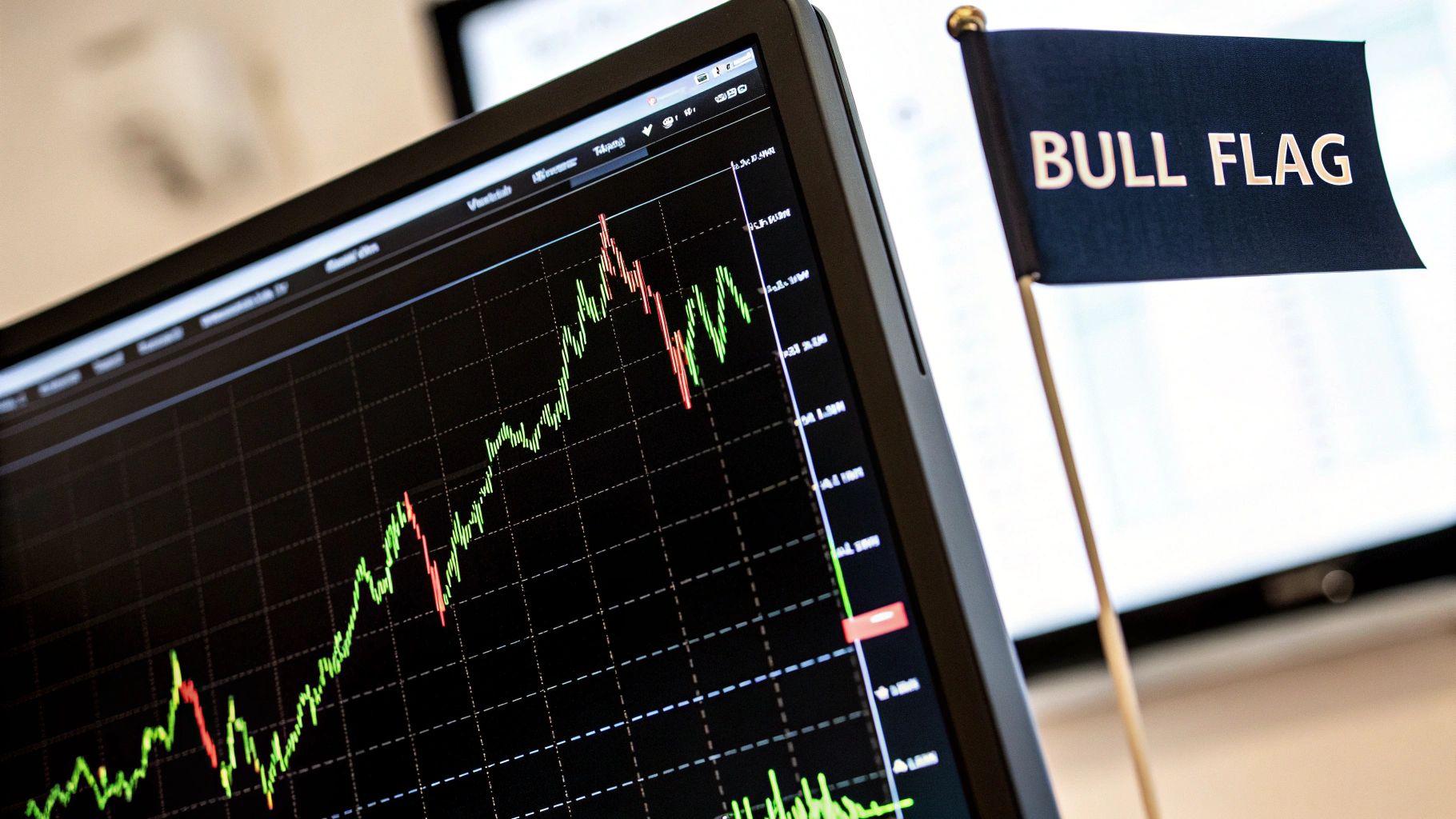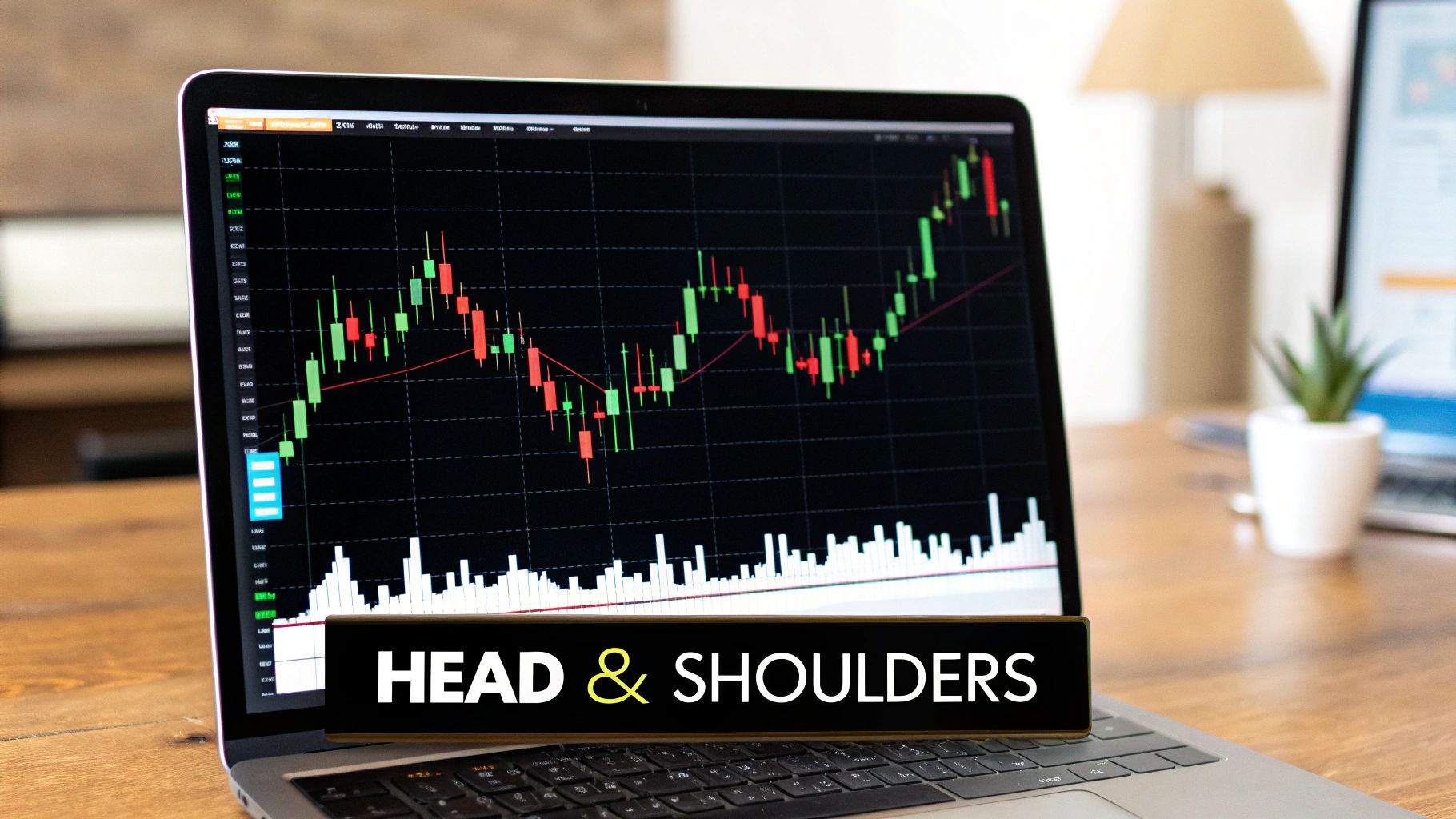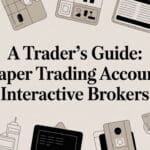Feeling lost in the endless stream of stock tickers and flashing lights? Many traders, both new and experienced, struggle to find consistent signals within the market’s chaotic intraday movements. We’ve all been there — feeling the frustration of a trade going against us or the anxiety of missing a great opportunity. The secret isn’t a magical indicator, but learning to read the story the price action is telling. These visual formations, known as day trade chart patterns, represent the collective psychology of buyers and sellers, offering clues about potential continuations or reversals in momentum.
This guide moves beyond simple textbook definitions to provide a practical roadmap for identifying and trading these setups. We will dissect eight of the most effective patterns, providing clear, actionable insights for each. You will learn not just what a pattern looks like, but also how to identify potential entry and exit points, manage risk, and integrate these strategies into a disciplined trading plan.
Think of this as a structured approach to interpreting market behavior. Our goal is not to suggest guaranteed profits — trading is a game of probabilities, not certainties. Instead, we aim to equip you with a repeatable process for spotting high-probability opportunities. By mastering these foundational patterns, you can build the skills and confidence necessary to navigate the markets with a more strategic and disciplined mindset, turning market noise into actionable intelligence for your trading journey.
1. Bull Flag Pattern
The bull flag is one of the most respected day trade chart patterns for traders looking to capitalize on existing momentum. This continuation pattern signals a brief pause or consolidation in a strong uptrend before the next potential move higher. It consists of two main parts: the “flagpole,” which is a sharp, near-vertical price surge, followed by the “flag,” a period of consolidation where the price drifts slightly downward within a tight, parallel channel.
This pattern is a visual representation of market psychology. The initial strong move (the flagpole) shows aggressive buying pressure. The subsequent consolidation (the flag) indicates that profit-takers are being absorbed by new buyers who believe the uptrend will continue, preventing a significant price drop. This healthy consolidation builds energy for the next leg up.

How to Trade the Bull Flag
A disciplined approach is crucial when trading this pattern. The primary entry signal occurs when the price breaks decisively above the upper trendline of the flag consolidation. This breakout should ideally be accompanied by a noticeable increase in volume, confirming renewed buyer interest.
- Entry Signal: A candle closes firmly above the flag’s upper resistance line.
- Stop-Loss Placement: A logical stop-loss can be placed just below the flag’s lower support trendline. This defines your risk clearly and protects you if the pattern fails.
- Profit Target: A common method for setting a profit target is to measure the height of the initial flagpole and project that distance upward from the breakout point. This provides a measurable risk-reward objective.
Practical Example: On a strong trending day, a stock like Tesla (TSLA) might surge from $180 to $185 (the flagpole), then consolidate between $184.50 and $183.50. A day trader would patiently watch for a breakout above $184.50 on high volume to enter a long position, perhaps targeting a move toward $190 (the $5 flagpole height added to the breakout). Risk is managed by placing a stop-loss just below the $183.50 support level.
2. Head and Shoulders (Reversal)
The head and shoulders is one of the classic day trade chart patterns used to identify a potential trend reversal from bullish to bearish. This reliable pattern signals that buying momentum is fading and sellers are beginning to take control. It is composed of three distinct peaks: two lower peaks (the shoulders) on either side of a single higher peak (the head). A “neckline” is drawn connecting the lows of the two troughs between these peaks.
This formation visually represents a struggle between buyers and sellers. The first shoulder and the head show strong buying pressure, but the failure to make a new high on the right shoulder indicates exhaustion. The subsequent break below the neckline confirms that sellers have overpowered buyers, suggesting a probability of a continued move downward.

How to Trade the Head and Shoulders
Trading this reversal pattern requires patience and confirmation to avoid false signals. The key trigger is the breakdown below the neckline, which validates the pattern and signals a potential short entry. It is crucial to wait for a decisive close below this level, preferably with an increase in trading volume.
- Entry Signal: A candle closes firmly below the neckline support level.
- Stop-Loss Placement: A conservative stop-loss can be placed just above the high of the right shoulder. This level defines your maximum risk if the pattern fails and the price reverses upward.
- Profit Target: To estimate a profit target, measure the vertical distance from the peak of the head down to the neckline. Project this distance downward from the point where the price breaks the neckline.
Practical Example: An asset like Crude Oil might form an intraday peak at $80 (left shoulder), rally to $81 (head), and fail at $80.10 (right shoulder), with a neckline at $79.50. A day trader would look for a break below $79.50 to enter a short position, placing a stop-loss above $80.10 and targeting a move toward $78.00 (the $1.50 head-to-neckline distance subtracted from the breakdown).
3. Double Top/Double Bottom
The double top and double bottom are classic reversal day trade chart patterns that signal a potential end to an existing trend. A double top, shaped like the letter “M,” forms after an uptrend when the price hits a resistance level twice and fails to break through. Conversely, a double bottom, shaped like a “W,” forms during a downtrend when the price finds support at the same level twice.
These patterns are powerful because they reveal a shift in market sentiment. In a double top, the failure to create a higher high on the second attempt shows that buying momentum is fading. For a double bottom, the inability to push to a lower low indicates that sellers are losing control. The area between the peaks (for a double top) or troughs (for a double bottom) forms a critical support or resistance level known as the “neckline.”
How to Trade Double Top/Double Bottom Patterns
Patience is key when trading these reversal patterns, as a premature entry can lead to significant losses. The most reliable entry signal is a confirmed break of the neckline, which validates that the trend has indeed reversed.
- Entry Signal: For a double top, enter a short position when a candle closes decisively below the neckline. For a double bottom, enter a long position when a candle closes firmly above the neckline.
- Stop-Loss Placement: Place a stop-loss just above the second peak for a double top, or just below the second trough for a double bottom. This defines your maximum risk if the original trend resumes.
- Profit Target: To set a profit target, measure the vertical distance from the peaks/troughs to the neckline. Project this distance downward from the neckline breakout for a double top or upward for a double bottom to estimate the potential move.
Practical Example: If the EUR/USD currency pair finds support at 1.0700 twice, forming a double bottom with a neckline at 1.0750, a day trader would look for a breakout above 1.0750. Upon entry, they might target a move to 1.0800 (the 50-pip distance from the bottom to the neckline projected upward) while placing a stop-loss just below the 1.0700 support.
4. Triangle Patterns (Ascending, Descending, Symmetrical)
Triangle patterns are among the most versatile day trade chart patterns, representing a period of consolidation and contracting volatility before a significant price move. These formations are defined by two converging trendlines, and they come in three distinct types: ascending (often bullish), descending (often bearish), and symmetrical (neutral, indicating a breakout could go either way). Each type provides clues about the underlying balance between buyers and sellers.
An ascending triangle has a flat upper resistance line and a rising lower support line, indicating buyers are becoming more aggressive. A descending triangle is the opposite, with a flat lower support level and a declining upper resistance line, signaling growing seller strength. A symmetrical triangle features both a declining resistance line and a rising support line, showing indecision before an eventual breakout. Mastering these patterns is a core skill when learning how to read stock charts.

How to Trade Triangle Patterns
Trading triangles requires patience to wait for a confirmed breakout, as entering too early within the consolidation can lead to losses. The key is to watch for a decisive price move outside the pattern’s boundaries, ideally on increased volume, which signals the start of a new trend or the continuation of the prior one.
- Entry Signal: For ascending triangles, enter on a candle close above the flat resistance. For descending triangles, enter on a close below the flat support. For symmetrical triangles, enter on a close outside either trendline.
- Stop-Loss Placement: A sound stop-loss can be placed just inside the triangle on the opposite side of the breakout. For example, after a bullish breakout from an ascending triangle, the stop would go just below the rising support trendline.
- Profit Target: A common target is calculated by measuring the height of the triangle at its widest point (the base) and projecting that distance from the breakout point.
Practical Example: A stock like Amazon (AMZN) might form an ascending triangle on a 15-minute chart, with resistance at $185 and rising support from $182. A day trader would watch for a high-volume break above $185 to go long, placing a stop below the rising trendline and targeting a move to $188 (the $3 base height added to the breakout).
5. ABCD Pattern
The ABCD pattern is a foundational harmonic pattern used by traders to identify potential price reversals with a high degree of precision. As one of the more structured day trade chart patterns, it uses specific Fibonacci ratios to anticipate where a trend might exhaust itself and reverse. The pattern consists of three consecutive price swings, or legs (AB, BC, and CD), which form a distinct zigzag shape on the chart.
This pattern’s power lies in its geometric and mathematical harmony. The AB leg is the initial directional move, followed by the BC leg, which is a partial retracement of AB. The final CD leg moves in the same direction as AB and completes at a point determined by Fibonacci projections of the previous two legs. This structure helps traders pinpoint potential turning points in the market with more accuracy.
The following infographic illustrates the key steps and Fibonacci ratios that define the ABCD pattern’s structure.
This visual process flow highlights how the completion of one leg directly informs the potential target for the next, creating a predictable and tradable structure.
How to Trade the ABCD Pattern
Trading the ABCD pattern requires proficiency with Fibonacci tools and a patient, disciplined approach to execution. The primary entry signal occurs as the price approaches the projected completion point of the CD leg, known as the Potential Reversal Zone (PRZ).
- Entry Signal: Look to enter a trade with a limit order at or near the completion of the CD leg (Point D). This point is typically calculated as a 127.2% or 161.8% Fibonacci extension of the BC leg.
- Stop-Loss Placement: A logical stop-loss should be placed just beyond the calculated Point D. This protects your capital if the harmonic pattern fails and the price continues past the expected reversal zone.
- Profit Target: Traders often set initial profit targets at the 38.2% and 61.8% Fibonacci retracement levels of the entire AD move. Watching previous swing points can also provide logical take-profit levels.
Practical Example: On a 5-minute chart, EUR/USD might rally from 1.0710 to 1.0750 (AB leg), then retrace to 1.0725 (BC leg). A trader would project the CD leg to complete near 1.0765. They could then place a limit order to sell at that level, anticipating a bearish reversal, with a stop-loss set just above that entry price.
6. Bull/Bear Pennant
The pennant is a rapid-fire continuation pattern, making it one of the most effective day trade chart patterns for capitalizing on strong, existing momentum. Similar to flags, pennants signal a brief consolidation after a significant price move before the trend is likely to resume. It consists of a “pole,” which is a sharp, strong price move, followed by a short consolidation phase contained within two converging trendlines, forming a small, symmetrical triangle (the “pennant”).
This pattern represents a momentary equilibrium between buyers and sellers. After a powerful move (the pole), some traders take profits while new traders enter, believing the trend will continue. This brief battle creates the tight, converging price action of the pennant. The pattern’s quick formation and resolution indicate that the pause is temporary and the underlying trend’s strength is building for another push.
How to Trade the Bull/Bear Pennant
Trading pennants requires quick identification and a decisive entry strategy. The primary signal is a breakout from the converging trendlines in the direction of the initial flagpole, ideally on a surge in volume that confirms the trend’s continuation.
- Entry Signal: A candle closes decisively outside the pennant’s trendline. For a bull pennant, this is above the upper resistance; for a bear pennant, it’s below the lower support.
- Stop-Loss Placement: A protective stop-loss should be placed just inside the pennant on the opposite side of the breakout. This contains risk if the pattern fails and the price reverses.
- Profit Target: The most common profit target is calculated by measuring the height of the flagpole and projecting that distance from the breakout point. This method provides a clear risk-to-reward objective.
Practical Example: Crude oil futures might rally from $80 to $81 (the pole), then consolidate between $80.80 and $80.60 within converging lines. A day trader would watch for a volume-supported breakout above the upper trendline to go long, targeting a move toward $81.80 (the $1 pole height added to the breakout point). Combining this with trend indicators, such as those explained in our guide to how to use moving averages, can further confirm the trade’s validity.
7. Cup and Handle
Popularized by legendary growth investor William O’Neil, the cup and handle is a powerful bullish continuation pattern. While often associated with longer-term charts, it frequently appears on intraday timeframes, making it one of the most compelling day trade chart patterns for spotting potential breakouts. The pattern visually resembles a teacup, consisting of a rounded bottom (the “cup”) followed by a smaller, slight downward drift in price (the “handle”).
This formation tells a story of accumulation. The “cup” shows a gradual bottoming process where initial selling pressure is absorbed by patient buyers, forming a U-shape rather than a sharp V. The “handle” represents a final, shallow pullback on lower volume, indicating that most sellers have been flushed out. This sets the stage for a potential surge as buyers regain control.
How to Trade the Cup and Handle
Trading this pattern requires patience, as the setup can take time to form even on a 5-minute chart. The key is to wait for confirmation before entering. The primary trigger is a decisive price break above the resistance line formed at the top of the handle.
- Entry Signal: A candle closes convincingly above the handle’s upper trendline, ideally on volume that is at least 50% above its recent average.
- Stop-Loss Placement: A common stop-loss is placed just below the low of the handle. This tight stop defines your risk, protecting you if the breakout fails and turns into a trap.
- Profit Target: A standard technique is to measure the depth of the cup from its bottom to the breakout level and project this distance upward from the entry point to set a logical profit target.
Practical Example: A stock like Microsoft (MSFT) might form a cup from $425 down to $422 and back up. It then forms a handle by pulling back to $424. A day trader would watch for a high-volume breakout above the handle’s resistance around $425.50, placing a stop below $424 and targeting a move toward $428.50 (the $3 cup depth added to the breakout).
8. Three Drives Pattern
The three drives is a predictive reversal pattern based on harmonic principles that signals the potential exhaustion of a trend. As one of the more advanced day trade chart patterns, it identifies a point where market momentum is waning. The pattern consists of three consecutive, symmetrical price pushes (drives) in the direction of the trend, each separated by a corrective pullback.
This structure reflects a market struggling to continue its trajectory. The first two drives represent strong attempts to push the price further, but the third and final drive often shows less conviction, signaling that the dominant force (buyers in an uptrend or sellers in a downtrend) is losing control. The precise symmetry and Fibonacci relationships between the drives and corrections are what give this pattern its predictive power.
How to Trade the Three Drives Pattern
Trading the three drives requires patience and precision, as the entry occurs at the completion point of the third drive. Confirmation from other indicators, like momentum divergence on the RSI or MACD across the three peaks (or troughs), significantly increases the pattern’s reliability.
- Entry Signal: Enter a reversal trade (short at a top, long at a bottom) as the price action completes the third drive, ideally at the 1.272 or 1.618 Fibonacci extension of the prior correction.
- Stop-Loss Placement: A crucial stop-loss should be placed just beyond the completion point of the third drive. Proper risk management techniques are essential, as harmonic patterns can sometimes extend further than projected. Learn more about risk management techniques on tradereview.app.
- Profit Target: Initial profit targets can be set at the 38.2% and 61.8% Fibonacci retracement levels of the entire three-drive move.
Practical Example: Bitcoin might form three distinct peaks near a major resistance level. A trader would measure the corrections and projections, looking for the classic harmonic ratios. Upon completion of the third drive, especially if confirmed by weakening buying volume and RSI divergence (where price makes a new high but RSI doesn’t), they could enter a short position, placing a stop-loss just above the final peak.
Top 8 Day Trade Chart Patterns Comparison
| Pattern | Implementation Complexity 🔄 | Resource Requirements 💡 | Expected Outcomes 📊 | Ideal Use Cases 💡 | Key Advantages ⭐⚡ |
|---|---|---|---|---|---|
| Bull Flag Pattern | Moderate – requires volume and trendline analysis | Basic charting tools, volume data, multiple timeframes | High probability continuation (≈68% success) | Trending markets, day trading on 5-15 min charts | Clear entries/exits, favorable risk-reward, volume confirmation ⭐ |
| Head and Shoulders (Reversal) | Moderate to High – pattern structure and neckline needed | Charting, volume analysis, patience for formation | Reliable reversal (≈83% success) | Identifying trend reversals on 15-min+ charts | Strong statistical reliability, clear targets, stop-loss placement ⭐ |
| Double Top/Double Bottom | Low to Moderate – simpler pattern recognition | Basic charting, volume data required | Moderate reliability (65%-79% success) | Early reversal detection across all timeframes | Easy identification, clear risk/reward, strong psychological levels ⭐ |
| Triangle Patterns (Ascending, Descending, Symmetrical) | Moderate – requires accurate trendline drawing and multiple touchpoints | Charting tools, volume monitoring | Variable (55%-67%) continuation or reversal | Consolidation and breakout anticipation on all timeframes | Multiple entry points, clear breakouts, objective targets ⚡ |
| ABCD Pattern | High – requires Fibonacci tools and pattern recognition | Fibonacci retracement/extension tools, precise measurements | High reward-to-risk at pattern completion | Reversal or continuation on 5-min to 1-hour charts | Precise entries/stops, mathematical basis reduces subjectivity ⭐ |
| Bull/Bear Pennant | Low to Moderate – quick identification with volume | Basic charting, volume data, fast execution | Moderate continuation (~55% target reach) | Rapid trend continuation on intraday charts | Fast formation, clear entry, excellent risk-reward, volume confirmed ⚡ |
| Cup and Handle | Moderate – patience required to identify rounded cup and handle | Time for pattern formation, volume data | Very high success (~95% in bull markets) | Bullish continuation on daily and intraday charts | Clear structure, strong accumulation signal, excellent risk-reward ⭐ |
| Three Drives Pattern | High – requires Fibonacci mastery and time symmetry | Fibonacci tools, pattern recognition, patience | Precise reversal signals with good rewards | Trend exhaustion and reversals on 15-min+ charts | High accuracy at trend exhaustion, objective entries, risk controls ⭐ |
From Patterns to Profits: The Path of a Disciplined Trader
Navigating the fast-paced world of day trading requires more than just recognizing shapes on a screen. Throughout this guide, we’ve dissected critical day trade chart patterns, from the powerful continuation signals of Bull Flags to the decisive reversal warnings of the Head and Shoulders. We’ve explored the measured moves of the ABCD pattern and the patient setups of the Cup and Handle, each offering a unique window into market psychology.
However, knowledge alone does not create a consistently profitable trader. The bridge between recognizing a pattern and executing a successful trade is built with discipline, rigorous analysis, and an unwavering commitment to self-improvement. The real “alpha” isn’t found in a secret pattern; it’s forged in the process of review and refinement. Every trader faces losses; the difference is what you learn from them.
Turning Theory into a Profitable System
The most significant leap you will make as a trader is from being a pattern spotter to a system builder. This involves moving beyond the individual trade and focusing on your long-term performance. Ask yourself the hard questions that separate amateurs from professionals:
- Which patterns yield the best results for your specific strategy? Is it the Ascending Triangle during the market open, or the Bear Flag in the afternoon?
- What are your most common execution errors? Do you consistently enter Double Bottoms too early or fail to take profits on a successful Three Drives pattern?
- How does market volatility affect your performance? Do your trend-following patterns underperform in choppy, range-bound markets?
Answering these questions is impossible without meticulous data. This is where a trading journal becomes your most critical tool. It transforms every trade, win or lose, into a valuable data point. By tagging each entry with the specific pattern, noting your emotional state, and tracking your performance metrics, you begin to see your own patterns as a trader.
Remember, the goal is not to win every single trade — that’s an unrealistic and stressful pursuit. The true objective is to develop and execute a system where your wins, over time, are strategically larger than your losses. Mastering day trade chart patterns is a foundational skill, but integrating them into a disciplined, data-driven trading plan is what ultimately paves the path toward long-term consistency. Embrace the process, stay resilient through the learning curve, and let every chart tell you a story not just about the market, but about yourself.
Ready to stop guessing and start building a data-driven edge? TradeReview is a dedicated trading journal designed to help you analyze your performance, tag specific setups like the chart patterns we’ve discussed, and uncover the insights needed to refine your strategy. Sign up for free and turn your trading history into your greatest teacher at TradeReview.


